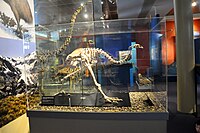Moa
| Moa Temporal range: Miocene - Holocene, 17–0.0006 Ma PreЄ Є O S D C P T J K Pg N | |
|---|---|
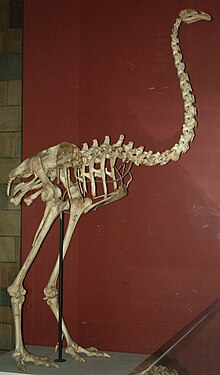 | |
North Island giant moa Skeleton | |
Scientific classification | |
| Kingdom: | Animalia |
| Phylum: | Chordata |
| Class: | Aves |
| Infraclass: | Palaeognathae |
Clade: | Notopalaeognathae |
| Order: | †Dinornithiformes Bonaparte, 1853[1] |
Type species | |
†Dinornis novaezealandiae Owen, 1843 | |
| Subgroups | |
See text | |
Diversity[2] | |
6 genera, 9 species | |
Synonyms[3] | |
| |
Moa[note 1] were nine species (in six genera) of now-extinct flightless birds endemic to New Zealand.[4][note 2] The two largest species, Dinornis robustus and Dinornis novaezelandiae, reached about 3.6 m (12 ft) in height with neck outstretched, and weighed about 230 kg (510 lb).[5] It is estimated that, when Polynesians settled New Zealand circa 1280, the moa population was about 58,000.[6]
Moa belong to the order Dinornithiformes, traditionally placed in the ratite group.[4] However, their closest relatives have been found by genetic studies to be the flighted South American tinamous, once considered to be a sister group to ratites.[7] The nine species of moa were the only wingless birds lacking even the vestigial wings which all other ratites have. They were the dominant herbivores in New Zealand's forest, shrubland and subalpine ecosystems for thousands of years, and until the arrival of the Māori were hunted only by the Haast's eagle. Moa extinction occurred around 1300[8]–1440 ± 20 years, primarily due to overhunting by Māori.[6]
Contents
1 Description
2 Evolutionary relationships
3 Classification
3.1 Taxonomy
3.2 Phylogeny
4 Distribution and habitat
4.1 South Island
4.2 North Island
5 Behaviour and ecology
5.1 Diet
5.2 Reproduction
6 Relationship with humans
6.1 Extinction
6.2 Surviving remains
6.3 Feathers and soft tissues
6.4 Claims of moa survival
6.5 Potential revival
7 Moa in literature and culture
8 See also
9 Footnotes
10 Notes
11 References
12 External links
Description

A size comparison between 4 moa species and a human. 1. Dinornis novaezealandiae 2. Emeus crassus 3. Anomalopteryx didiformis 4. Dinornis robustus
Although moa skeletons were traditionally reconstructed in an upright position to create impressive height, analysis of their vertebral articulation indicates that they probably carried their heads forward,[9] in the manner of a kiwi. The spine was attached to the rear of the head rather than the base, indicating the horizontal alignment. This would have allowed them to graze on low-elevation vegetation, while being able to lift their heads and browse trees when necessary. This has resulted in a reconsideration of the height of larger moa.
Although there is no surviving record of what sounds moa made, some idea of their calls can be gained from fossil evidence. The trachea of moa were supported by many small rings of bone known as tracheal rings. Excavation of these rings from articulated skeletons has shown that at least two moa genera (Euryapteryx and Emeus) exhibited tracheal elongation, that is, their trachea were up to 1 metre (3 ft) long and formed a large loop within the body cavity.[9] These are the only ratites known to exhibit this feature, which is also present in several other bird groups including swans, cranes, and guinea fowl. The feature is associated with deep, resonant vocalisations that can travel long distances.
Evolutionary relationships

A comparison of a kiwi (left), ostrich (center), and Dinornis (right), each with its egg.
Research published starting in 2010 has found that the moa's closest cousins are small terrestrial South American birds called the tinamous which can fly.[7][10][11][12] Previously, the kiwi, the Australian emu, and cassowary[13] were thought to be most closely related to the moa.
Although dozens of species were described in the late 19th century and early 20th century, many were based on partial skeletons and turned out to be synonyms. Currently, eleven species are formally recognised, although recent studies using ancient DNA recovered from bones in museum collections suggest that distinct lineages exist within some of these. One factor that has caused much confusion in moa taxonomy is the intraspecific variation of bone sizes, between glacial and inter-glacial periods (see Bergmann’s rule and Allen’s rule) as well as sexual dimorphism being evident in several species. Dinornis seems to have had the most pronounced sexual dimorphism, with females being up to 150% as tall and 280% as heavy as males—so much bigger that they were formerly classified as separate species until 2003.[14][15] A 2009 study showed that Euryapteryx curtus and Euryapteryx gravis were synonyms.[16] A 2010 study explained size differences among them as sexual dimorphism.[17] A 2012 morphological study interpreted them as subspecies instead.[18]
Ancient DNA analyses have determined that there were a number of cryptic evolutionary lineages in several moa genera.[19] These may eventually be classified as species or subspecies; Megalapteryx benhami (Archey) which is synonymised with M. didinus (Owen) because the bones of both share all essential characters. Size differences can be explained by a north-south cline combined with temporal variation such that specimens were larger during the Otiran glacial period (the last ice age in New Zealand). Similar temporal size variation is known for the North Island Pachyornis mappini.[20] Some of the other size variation for moa species can probably be explained by similar geographic and temporal factors.[21]
The earliest moa remains come from the Miocene Saint Bathans Fauna. Known from multiple eggshells and hindlimb elements, these represent at least two species of already fairly large sized species.[22]
Classification
Taxonomy

Emeus crassus and Pachyornis elephantopus
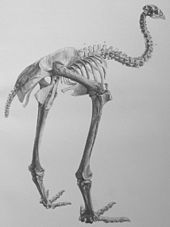
Anomalopteryx didiformis skeleton
The currently recognised genera and species are:[5]
- Order †Dinornithiformes (Gadow 1893) Ridgway 1901 [Dinornithes Gadow 1893; Immanes Newton 1884] (moa)
- Family Dinornithidae Owen 1843 [Palapteryginae Bonaparte 1854; Palapterygidae Haast 1874; Dinornithnideae Stejneger 1884] (giant moa)
- Genus Dinornis
North Island giant moa, Dinornis novaezealandiae (North Island, New Zealand)
South Island giant moa, Dinornis robustus (South Island, New Zealand)
- Genus Dinornis
- Family Emeidae (Bonaparte 1854) [Emeinae Bonaparte 1854; Anomalopterygidae Oliver 1930; Anomalapteryginae Archey 1941] (lesser moa)
- Genus Anomalopteryx
Bush moa, Anomalopteryx didiformis (South Island, New Zealand)
- Genus Emeus
Eastern moa, Emeus crassus (South Island, New Zealand)
- Genus Euryapteryx
Coastal moa, Euryapteryx curtus (North and South Island, New Zealand)
- Genus Pachyornis
Heavy-footed moa, Pachyornis elephantopus (South Island, New Zealand)
Mantell's moa, Pachyornis geranoides (North Island, New Zealand)
Crested moa, Pachyornis australis (South Island, New Zealand)[2]
- Genus Anomalopteryx
- Family Megalapterygidae
Genus Megalapteryx
Upland moa, Megalapteryx didinus (South Island, New Zealand)
- Family Dinornithidae Owen 1843 [Palapteryginae Bonaparte 1854; Palapterygidae Haast 1874; Dinornithnideae Stejneger 1884] (giant moa)
Two unnamed species from the Saint Bathans Fauna.[22]
Phylogeny

Preserved footprints of a D. robustus found in 1911.
Because moa are a group of flightless birds with no vestiges of wing bones, questions have been raised about how they arrived in New Zealand, and from where. There are many theories about the moa's arrival and radiation on New Zealand, but the most recent theory suggests that the moa arrived on New Zealand about 60 million years ago (Mya) and split from the "basal" (see below) moa species, Megalapteryx about 5.8 Mya[23] instead of the 18.5 Mya split suggested by Baker et al. (2005). This does not necessarily mean there was no speciation between the arrival 60 Mya and the basal split 5.8 Mya, but the fossil record is lacking and is it most likely that early moa lineages existed but became extinct before the basal split 5.8 Mya.[24] The presence of Miocene-aged species certainly suggests that moa diversification began before the split between Megalapteryx and the other taxa.[22]
The Oligocene Drowning Maximum event, which occurred about 22 Mya, when only 18% of present-day New Zealand was above sea level, is very important in the moa radiation. Because the basal moa split occurred so recently (5.8 Mya), it was argued that ancestors of the Quaternary moa lineages could not have been present on both the South and North island remnants during the Oligocene drowning.[25] This does not imply that moa were previously absent from the North Island, but that only those from the South Island survived, because only the South Island was above sea level. Bunce et al. (2009) argued that moa ancestors survived in the South Island and then recolonized the North Island about 2 My later, when the two islands rejoined after 30 My of separation.[15] The presence of Miocene moas in the Saint Bathans fauna seems to suggest that these birds increased in size soon after the Oligocene Drowning Event, if they were affected by it at all.[22]
Bunce et al. also concluded that the highly complex structure of the moa lineage was caused by the formation of the Southern Alps about 6 Mya, and the habitat fragmentation on both islands resulting from Pleistocene glacial cycles, volcanism, and landscape changes.[15] On the left is a phylogeny of Palaeognathae generated by Mitchell (2014)[11] with some clade names after Yuri et al. (2013)[26] The below right is a species level phylogeny of Dinornithiformes.[15]
.mw-parser-output table.clade{border-spacing:0;margin:0;font-size:100%;line-height:100%;border-collapse:separate;width:auto}.mw-parser-output table.clade table.clade{width:100%}.mw-parser-output table.clade td{border:0;padding:0;vertical-align:middle;text-align:center}.mw-parser-output table.clade td.clade-label{width:0.8em;border:0;padding:0 0.2em;vertical-align:bottom;text-align:center}.mw-parser-output table.clade td.clade-slabel{border:0;padding:0 0.2em;vertical-align:top;text-align:center}.mw-parser-output table.clade td.clade-bar{vertical-align:middle;text-align:left;padding:0 0.5em}.mw-parser-output table.clade td.clade-leaf{border:0;padding:0;text-align:left;vertical-align:middle}.mw-parser-output table.clade td.clade-leafR{border:0;padding:0;text-align:right}
|
|
Distribution and habitat
Analyses of fossil moa bone assemblages have provided detailed data on the habitat preferences of individual moa species, and revealed distinctive regional moa faunas:[9][27][28][29][30][31][32]
South Island

A restoration of Dinornis robustus and Pachyornis elephantopus, both from the South Island.
The two main faunas identified in the South Island include: 1. The fauna of the high rainfall west coast beech (Nothofagus) forests that included Anomalopteryx didiformis (bush moa) and Dinornis robustus (South Island giant moa); and 2. The fauna of the dry rainshadow forest and shrublands east of the Southern Alps that included Pachyornis elephantopus (heavy-footed moa), Euryapteryx gravis, Emeus crassus and Dinornis robustus. The two other moa species that existed in the South Island; Pachyornis australis and Megalapteryx didinus might be included in a ‘subalpine fauna’, along with the widespread Dinornis robustus. P. australis is the rarest of the moa species, and the only one not yet found in Maori middens.
Its bones have been found in caves in the northwest Nelson and Karamea districts (such as Honeycomb Hill Cave), and some sites around the Wanaka district. M. didinus is more widespread. It is named "upland moa" because its bones are commonly found in the subalpine zone. However, it also occurred down to sea level where there was suitable steep and rocky terrain (such as Punakaiki on the west coast and Central Otago). Their distributions in coastal areas have been rather unclear, but were present at least in several locations such as on Kaikoura, Otago Peninsula,[33] and Karitane.[34]
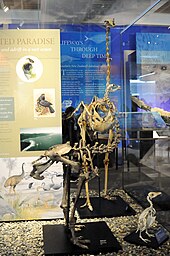
The skeletons of an Eastern moa (left) ostrich (rear) and Fiordland penguin (right) in the Otago Museum.
North Island
Significantly less is known about North Island paleofaunas, due to a paucity of fossil sites compared to the South Island; however, the basic pattern of moa-habitat relationships was the same.[9] Although the South Island and the North Island shared some moa species (Euryapteryx gravis, Anomalopteryx didiformis), most were exclusive to one island, reflecting divergence over several thousand years since lower sea level had resulted in a land bridge across Cook Strait.[9]
In the North Island, Dinornis novaezealandiae and Anomalopteryx didiformis dominated in high rainfall forest habitat; a similar pattern to the South Island. The other moa species present in the North Island (Euryapteryx gravis, E. curtus, and Pachyornis geranoides) tended to inhabit drier forest and shrubland habitats. P. geranoides occurred throughout the North Island, while the distributions of E. gravis and E. curtus were almost mutually exclusive, the former having only been found in coastal sites around the southern half of the North Island.[9]
Behaviour and ecology
Approximately eight moa trackways, with fossilised moa footprint impressions in fluvial silts have been found throughout the North Island, including Waikanae Creek (1872), Napier (1887), Manawatu River (1895), Marton (1896), Palmerston North (1911) (see photograph to left), Rangitikei River (1939), and underwater in Lake Taupo (1973). Analysis of the spacing of these tracks indicates walking speeds of between 3 and 5 km/h (1.75–3 mph).[9]
Diet

D. novaezealandiae skull at the Museum für Naturkunde, Berlin.
Although feeding moa were never observed by scientists, their diet has been deduced from fossilised contents of their gizzards[35][36] and coprolites,[37] as well as indirectly through morphological analysis of skull and beak, and stable isotope analysis of their bones.[9] Moa fed on a range of plant species and plant parts, including fibrous twigs and leaves taken from low trees and shrubs. The beak of Pachyornis elephantopus was analogous to a pair of secateurs, and was able to clip the fibrous leaves of New Zealand flax (Phormium tenax) and twigs up to at least 8 mm in diameter.[36]
Like many other birds, moa swallowed gizzard stones (gastroliths), which were retained in their muscular gizzards, providing a grinding action that allowed them to eat coarse plant material. These stones were commonly smooth, rounded quartz pebbles, but stones over 110 millimetres (4 in) in length have been found amongst preserved moa gizzard contents.[36]Dinornis gizzards could often contain several kilograms of stones.[9] It has been suggested that moas exercised a certain selectivity in the choice of gizzard stones and chose the hardest pebbles.[38]
Reproduction
It has been long suspected that the pairs of species of moa described as Euryapteryx curtus/E. exilis, Emeus huttonii/E. crassus, and Pachyornis septentrionalis/P. mappini constituted males and females, respectively. This has been confirmed by analysis for sex-specific genetic markers of DNA extracted from bone material.[14]
For example, before 2003 three species of Dinornis were recognised: South Island giant moa (D. robustus), North Island giant moa (D. novaezealandiae) and slender moa (D. struthioides). However, DNA showed that all D. struthioides were males, and all D. robustus were females. Therefore, the three species of Dinornis were reclassified as two species, one each formerly occurring on New Zealand's North Island (D. novaezealandiae) and South Island (D. robustus);[14][39]D. robustus however, comprises three distinct genetic lineages and may eventually be classified as many species, as discussed above.
Examination of growth rings in moa cortical bone has revealed that these birds were K-selected, as are many other large endemic New Zealand birds.[13] They are characterised by having low fecundity and a long maturation period, taking approximately ten years to reach adult size. The large Dinornis species took as long to reach adult size as small moa species, and as a result had fast skeletal growth during their juvenile years.[13]
There is no evidence to suggest that moa were colonial nesters. While evidence of moa nesting is often inferred from accumulations of eggshell fragments found in caves and rock shelters, little evidence exists of the nests themselves. Excavations of rock shelters in the eastern North Island during the 1940s uncovered moa nests, which were described as "small depressions obviously scratched out in the soft dry pumice".[40] Moa nesting material has also been recovered from rock shelters in the Central Otago region of the South Island, where the dry climate has resulted in the preservation of plant material used to construct the nesting platform (including twigs that have been clipped by moa bills).[41]Seeds and pollen within moa coprolites found amongst the nesting material provide evidence that the nesting season was late spring to summer.[41]
Fragments of moa eggshell are often found in archaeological sites and sand dunes around the New Zealand coast. Thirty six whole moa eggs exist in museum collections and vary greatly in size (from 120–240 millimetres (4.7–9.4 in) in length and 91–178 millimetres (3.6–7.0 in) wide).[42] The outer surface of moa eggshell is characterised by small slit-shaped pores. The eggs of most moa species were white, although those of the upland moa (Megalapteryx didinus) were blue-green.[43]
A 2010 study by Huynen et al. has found that the eggs of certain species were fragile, only around a millimeter in thickness: "Unexpectedly, several thin-shelled eggs were also shown to belong to the heaviest moa of the genera Dinornis, Euryapteryx, and Emeus, making these, to our knowledge, the most fragile of all avian eggs measured to date. Moreover, sex-specific DNA recovered from the outer surfaces of eggshells belonging to species of Dinornis and Euryapteryx suggest that these very thin eggs were likely to have been incubated by the lighter males. The thin nature of the eggshells of these larger species of moa, even if incubated by the male, suggests that egg breakage in these species would have been common if the typical contact method of avian egg incubation was used."[43] Despite the bird's extinction, the high yield of DNA available from recovered fossilized eggs has allowed the moa's genome to be sequenced.[44]
The skeleton of female upland moa with egg in unlaid position within the pelvic cavity in Otago Museum.
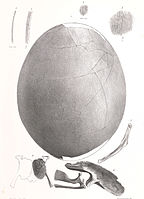
An egg and embryo fragments of Emeus crassus
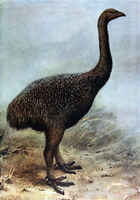
Restoration of an Upland moa
Relationship with humans
Extinction

An artist's rendition of a Haast's eagle attacking moa.
Before the arrival of human settlers, the moa's only predator was the massive Haast's eagle. New Zealand had been isolated for 80 million years and had few predators before human arrival, meaning that not only were its ecosystems extremely fragile but the native species were ill-equipped to cope with human predators.[45][46]
The Māori arrived sometime before 1300, and all moa genera were soon driven to extinction by hunting and, to a lesser extent, by habitat reduction due to forest clearance. By 1445, all moa had become extinct, along with the Haast's eagle which had relied on them for food. Recent research using carbon-14 dating of middens strongly suggests that the events leading to extinction took less than a hundred years,[47] rather than a period of exploitation lasting several hundred years, which is what had previously been hypothesized.
Some authors have speculated that a few Megalapteryx didinus may have persisted in remote corners of New Zealand until the 18th and even 19th centuries, but this view is not widely accepted.[48] Some Māori hunters claimed to be in pursuit of the moa as late as the 1770s; however, it is possible that these accounts did not refer to the hunting of actual birds as much as a now-lost ritual among South Islanders.[49]Whalers and sealers recalled seeing monstrous birds along the coast of the South Island, and in the 1820s, a man named George Pauley made an unverified claim of seeing a moa in the Otago region of New Zealand.[50][51]
An expedition in the 1850s under Lieutenant A. Impey reported two emu-like birds on a hillside in the South Island; an 1861 story from the Nelson Examiner told of three-toed footprints measuring 36 centimetres (14 in) between Takaka and Riwaka that were found by a surveying party; and finally in 1878 the Otago Witness published an additional account from a farmer and his shepherd.[51] An 80-year-old woman, Alice Mckenzie, claimed in 1959 that she had seen a moa in Fiordland bush in 1887, and again on a Fiordland beach when she was 17 years old. She claimed that her brother had also seen a moa on another occasion.[52]
Surviving remains

Sir Richard Owen holding the first discovered moa fossil and standing with a Dinornis skeleton, 1879.
Joel Polack, a trader who lived on the East Coast of the North Island from 1834 to 1837, recorded in 1838 that he had been shown "several large fossil ossifications" found near Mt Hikurangi. He was certain that these were the bones of a species of emu or ostrich, noting that "the Natives add that in times long past they received the traditions that very large birds had existed, but the scarcity of animal food, as well as the easy method of entrapping them, has caused their extermination". Polack further noted that he had received reports from Māori that a "species of Struthio" still existed in remote parts of the South Island.[53][54]
Dieffenbach[55] also refers to a fossil from the area near Mt Hikurangi, and surmises that it belongs to "a bird, now extinct, called Moa (or Movie) by the natives". In 1839 John W. Harris, a Poverty Bay flax trader who was a natural history enthusiast, was given a piece of unusual bone by a Māori who had found it in a river bank. He showed the 15 centimetres (6 in) fragment of bone to his uncle, John Rule, a Sydney surgeon, who sent it to Richard Owen, who at that time was working at the Hunterian Museum at the Royal College of Surgeons in London.[51]

Owen's first bone fragment
Owen puzzled over the fragment for almost four years. He established it was part of the femur of a big animal, but it was uncharacteristically light and honeycombed. Owen announced to a skeptical scientific community and the world that it was from a giant extinct bird like an ostrich, and named it Dinornis. His deduction was ridiculed in some quarters, but was proved correct with the subsequent discoveries of considerable quantities of moa bones throughout the country, sufficient to reconstruct skeletons of the birds.[51]
In July 2004, the Natural History Museum in London placed on display the moa bone fragment Owen had first examined, to celebrate 200 years since his birth, and in memory of Owen as founder of the museum.
Since the discovery of the first moa bones in the late 1830s, thousands more have been found. They occur in a range of late Quaternary and Holocene sedimentary deposits, but are most common in three main types of site: caves, dunes, and swamps.

Palaeontologists working on moa bone deposits in the 'Graveyard', Honeycomb Hill Cave System. This cave is a closed scientific reserve.
Bones are commonly found in caves or ‘'tomo'’ (the Maori word for doline or sinkhole; often used to refer to pitfalls or vertical cave shafts). The two main ways that the moa bones were deposited in such sites were: 1. birds that entered the cave to nest or escape bad weather, and subsequently died in the cave; and 2. birds that fell into a vertical shaft and were unable to escape. Moa bones (and the bones of other extinct birds) have been found in caves throughout New Zealand, especially in the limestone/marble areas of northwest Nelson, Karamea, Waitomo, and Te Anau.
Moa bones and eggshell fragments sometimes occur in active coastal sand dunes, where they may erode from paleosols and concentrate in ‘blowouts’ between dune ridges. Many such moa bones predate human settlement, although some originate from Maori midden sites, which frequently occur in dunes near harbours and river mouths (for example the large moa hunter sites at Shag River, Otago, and Wairau Bar, Marlborough).

An excavation in Kapua Swamp, 1894.
Densely intermingled moa bones have been encountered in swamps throughout New Zealand. The most well-known example is at Pyramid Valley in north Canterbury,[56] where bones from at least 183 individual moa have been excavated, mostly by Roger Duff of Canterbury Museum.[57] Many explanations have been proposed to account for how these deposits formed, ranging from poisonous spring waters to floods and wildfires. However the currently accepted explanation is that the bones accumulated at a slow rate over thousands of years, from birds that had entered the swamps to feed and became trapped in the soft sediment.[58]
Feathers and soft tissues
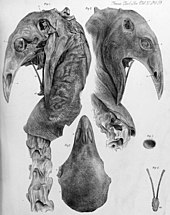
A Megalapteryx didinus head.
Several remarkable examples of moa remains have been found which exhibit soft tissues (muscle, skin, feathers), that were preserved through desiccation when the bird died in a naturally dry site (for example, a cave with a constant dry breeze blowing through it). Most of these specimens have been found in the semi-arid Central Otago region, the driest part of New Zealand. These include:
- Dried muscle on bones of a female Dinornis robustus found at Tiger Hill in the Manuherikia River Valley by gold miners in 1864[59] (currently held by Yorkshire Museum)
- Several bones of Emeus crassus with muscle attached, and a row of neck vertebrae with muscle, skin and feathers collected from Earnscleugh Cave near the town of Alexandra in 1870[60] (currently held by Otago Museum)
- An articulated foot of a male Dinornis giganteus with skin and foot pads preserved, found in a crevice on the Knobby Range in 1874[61] (currently held by Otago Museum)
- The type specimen of Megalapteryx didinus found near Queenstown in 1878[59] (currently held by Natural History Museum, London; see photograph of foot on this page)
- The lower leg of Pachyornis elephantopus, with skin and muscle, from the Hector Range in 1884;[48][61] (currently held by the Zoology Department, Cambridge University)
- The complete feathered leg of a Megalapteryx didinus from Old Man Range in 1894[62] (currently held by Otago Museum)
- The head of a Megalapteryx didinus found near Cromwell sometime before 1949[63] (currently held by the Museum of New Zealand).
Two specimens are known from outside the Central Otago region:
- A complete foot of Megalapteryx didinus found in a cave on Mount Owen near Nelson in the 1980s[64] (currently held by the Museum of New Zealand)
- A skeleton of Anomalopteryx didiformis with muscle, skin and feather bases collected from a cave near Te Anau in 1980.[65]
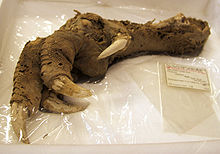
A preserved Megalapteryx foot, Natural History Museum.
In addition to these specimens, loose moa feathers have been collected from caves and rockshelters in the southern South Island, and based on these remains, some idea of the moa plumage has been achieved. The preserved leg of Megalapteryx didinus from the Old Man Range reveals that this species was feathered right down to the foot. This is likely to have been an adaptation to living in high altitude, snowy environments, and is also seen in the Darwin’s rhea, which lives in a similar seasonally snowy habitat.[9]
Moa feathers are up to 23 centimetres (9 in) long, and a range of colours have been reported, including reddish-brown, white, yellowish and purplish.[9] Dark feathers with white or creamy tips have also been found, and indicate that some moa species may have had plumage with a speckled appearance.[66]
Claims of moa survival

An early 20th century reconstruction of a moa hunt.
There has been occasional speculation—since at least the late 19th century,[67][68] and as recently as 1993[69][70][71] and 2008[72]—that some moa may still exist, particularly in the wilderness of South Westland and Fiordland. The 1993 report initially interested the Department of Conservation but the animal in a blurry photograph was identified as a red deer.[73][74]Cryptozoologists and others reputedly continue to search for them,[75] but their claims and supporting evidence (such as of purported footprints[72]) have earned little attention from mainstream experts, and are widely considered pseudoscientific.[48]
The rediscovery of the takahē in 1948 after none had been seen since 1898 showed that rare birds can exist undiscovered for a long time. However, the takahē is a much smaller bird than the moa, and was rediscovered after its tracks were identified—yet no reliable evidence of moa tracks has ever been found, and experts still contend that moa survival is extremely unlikely, since this would involve the ground-dwelling birds living unnoticed for over five hundred years in a region visited often by hunters and hikers.[72]
Potential revival
The creature has frequently been mentioned as a potential candidate for revival by cloning. Its iconic status, coupled with the facts that it only became extinct a few hundred years ago and that substantial quantities of moa remains exist, mean that it is often listed alongside such creatures as the dodo as leading candidates for resurrection.[76][77] Preliminary work involving the extraction of DNA has been undertaken by Japanese geneticist Ankoh Yasuyuki Shirota.[78][79]
Interest in the moa's potential for revival was further stirred in mid 2014 when New Zealand Member of Parliament Trevor Mallard suggested that bringing back some smaller species of moa within 50 years was a viable idea.[80] The idea was ridiculed by many, but gained support from some natural history experts.[81]
Moa in literature and culture

Harder's illustration of a Moa hunt
Heinrich Harder portrayed moa being hunted by Māori in the classic German collecting cards about extinct and prehistoric animals, "Tiere der Urwelt", in the early 1900s.
Allen Curnow's poem, "The Skeleton of the Great Moa in the Canterbury Museum, Christchurch" was published in 1943.[82][83]
See also
List of extinct New Zealand animals (birds)
Moa-nalo, several flightless ducks from the Hawaiian Islands that grew to be as large as geese.
Elephant birds, flightless ratites up to over 3 metres tall that once lived on the island of Madagascar.
General:
- Late Quaternary prehistoric birds
- Island gigantism
- Megafauna
Footnotes
^ Brands, S. (2008)
^ ab Stephenson, Brent (2009)
^ Brodkob, Pierce (1963). "Catalogue of fossil birds 1- Archaeopterygiformes through Ardeiformes". Biological sciences, Bulletin of the Florida State Museum. 7 (4): 180–293. Retrieved 30 December 2015..mw-parser-output cite.citation{font-style:inherit}.mw-parser-output .citation q{quotes:"""""""'""'"}.mw-parser-output .citation .cs1-lock-free a{background:url("//upload.wikimedia.org/wikipedia/commons/thumb/6/65/Lock-green.svg/9px-Lock-green.svg.png")no-repeat;background-position:right .1em center}.mw-parser-output .citation .cs1-lock-limited a,.mw-parser-output .citation .cs1-lock-registration a{background:url("//upload.wikimedia.org/wikipedia/commons/thumb/d/d6/Lock-gray-alt-2.svg/9px-Lock-gray-alt-2.svg.png")no-repeat;background-position:right .1em center}.mw-parser-output .citation .cs1-lock-subscription a{background:url("//upload.wikimedia.org/wikipedia/commons/thumb/a/aa/Lock-red-alt-2.svg/9px-Lock-red-alt-2.svg.png")no-repeat;background-position:right .1em center}.mw-parser-output .cs1-subscription,.mw-parser-output .cs1-registration{color:#555}.mw-parser-output .cs1-subscription span,.mw-parser-output .cs1-registration span{border-bottom:1px dotted;cursor:help}.mw-parser-output .cs1-ws-icon a{background:url("//upload.wikimedia.org/wikipedia/commons/thumb/4/4c/Wikisource-logo.svg/12px-Wikisource-logo.svg.png")no-repeat;background-position:right .1em center}.mw-parser-output code.cs1-code{color:inherit;background:inherit;border:inherit;padding:inherit}.mw-parser-output .cs1-hidden-error{display:none;font-size:100%}.mw-parser-output .cs1-visible-error{font-size:100%}.mw-parser-output .cs1-maint{display:none;color:#33aa33;margin-left:0.3em}.mw-parser-output .cs1-subscription,.mw-parser-output .cs1-registration,.mw-parser-output .cs1-format{font-size:95%}.mw-parser-output .cs1-kern-left,.mw-parser-output .cs1-kern-wl-left{padding-left:0.2em}.mw-parser-output .cs1-kern-right,.mw-parser-output .cs1-kern-wl-right{padding-right:0.2em}
^ ab OSNZ (2009)
^ ab Davies, S. J. J. F. (2003)
^ ab Perry, George L.W.; Wheeler, Andrew B.; Wood, Jamie R.; Wilmshurst, Janet M. (2014-12-01). "A high-precision chronology for the rapid extinction of New Zealand moa (Aves, Dinornithiformes)". Quaternary Science Reviews. 105: 126–135. Bibcode:2014QSRv..105..126P. doi:10.1016/j.quascirev.2014.09.025. Retrieved 2014-12-22.
^ ab Phillips, et al. (2010)
^ http://activeadventures.com/new-zealand/about/nature/birds-of-new-zealand/moa
^ abcdefghijk Worthy & Holdaway (2002)
^ Allentoft, M. E.; Rawlence, N. J. (2012-01-20). "Moa's Ark or volant ghosts of Gondwana? Insights from nineteen years of ancient DNA research on the extinct moa (Aves: Dinornithiformes) of New Zealand" (PDF). Annals of Anatomy - Anatomischer Anzeiger. 194: 36–51. doi:10.1016/j.aanat.2011.04.002.
^ ab Mitchell, K. J.; Llamas, B.; Soubrier, J.; Rawlence, N. J.; Worthy, T. H.; Wood, J.; Lee, M. S. Y.; Cooper, A. (2014-05-23). "Ancient DNA reveals elephant birds and kiwi are sister taxa and clarifies ratite bird evolution". Science. 344 (6186): 898–900. Bibcode:2014Sci...344..898M. doi:10.1126/science.1251981. PMID 24855267.
^ Baker, A. J.; Haddrath, O.; McPherson, J. D.; Cloutier, A. (2014). "Genomic Support for a Moa-Tinamou Clade and Adaptive Morphological Convergence in Flightless Ratites". Molecular Biology and Evolution. 31: 1686–1696. doi:10.1093/molbev/msu153. PMID 24825849.
^ abc Turvey et al. (2005)
^ abc Huynen, L. J.,et al. (2003)
^ abcd Bunce, M., et al. (2003)
^ Bunce, M.; Worthy, T. H.; Phillips, M. J.; Holdaway, R. N.; Willerslev, E.; Haile, J.; Shapiro, B.; Scofield, R. P.; Drummond, A.; Kamp, P. J. J.; Cooper, A. (2009). "The evolutionary history of the extinct ratite moa and New Zealand Neogene paleogeography". Proceedings of the National Academy of Sciences. 106 (49): 20646–20651. Bibcode:2009PNAS..10620646B. doi:10.1073/pnas.0906660106. PMC 2791642. PMID 19923428.
^ Gill, B. J. (2010). "Regional comparisons of the thickness of moa eggshell fragments (Aves: Dinornithiformes). In Proceedings of the VII International Meeting of the Society of Avian Paleontology and Evolution, ed. W.E. Boles and T.H. Worthy". Records of the Australian Museum. 62: 115–122. doi:10.3853/j.0067-1975.62.2010.1535.
^ Worthy, T. H.; Scofield, R. P. (2012). "Twenty-first century advances in knowledge of the biology of moa (Aves: Dinornithiformes): A new morphological analysis and moa diagnoses revised". New Zealand Journal of Zoology. 39 (2): 87–153. doi:10.1080/03014223.2012.665060.
^ Baker, A. J.; Huynen, L. J.; Haddrath, O.; Millar, C. D.; Lambert, D. M. (2005). "Reconstructing the tempo and mode of evolution in an extinct clade of birds with ancient DNA: The giant moas of New Zealand". Proceedings of the National Academy of Sciences. 102 (23): 8257–62. Bibcode:2005PNAS..102.8257B. doi:10.1073/pnas.0409435102. PMC 1149408. PMID 15928096.
^ Worthy (1987)
^ Worthy, et al. (1988)
^ abcd Tennyson, A.J.D.; Worthy, T.H.; Jones, C.M.; Scofield, R.P.; Hand, S.J. (2010). "Moa's Ark: Miocene fossils reveal the great antiquity of moa (Aves: Dinornithiformes) in Zealandia". Records of the Australian Museum. 62: 105–114. doi:10.3853/j.0067-1975.62.2010.1546.
^ Bunce, M.; Worthy, T. H.; Phillips, M. J.; Holdaway, R. N.; Willerslev, E.; Hailef, J.; Shapiro, B.; Scofield, R. P.; Drummond, A.; Kampk, P. J. J.; Cooper, A. (2009). "The evolutionary history of the extinct ratite moa and New Zealand Neogene paleogeography". Proceedings of the National Academy of Sciences. 106: 20646–20651. Bibcode:2009PNAS..10620646B. doi:10.1073/pnas.0906660106. PMC 2791642. PMID 19923428.
^ Allentoft, Morten; Nicolas Rawlence (2012). "Moa's ark or volant ghosts of Gondwana? Insights from nineteen years of ancient DNA research on the extinct moa (Aves: Dinornithiformes) of New Zealand" (PDF). Annals of Anatomy. 194: 36–51. doi:10.1016/j.aanat.2011.04.002.
^ Allentoft, Morten; Nicloas Rawlence (2012). "Moa's ark or volant ghosts of Gondwana? Insights from nineteen years of ancient DNA research on the extinct moa (Aves: Dinornithiformes) of New Zealand". Annals of Anatomy. 194: 36–51. doi:10.1016/j.aanat.2011.04.002.
^ Yuri, T (2013). "Parsimony and model-based analyses of indels in avian nuclear genes reveal congruent and incongruent phylogenetic signals". Biology. 2: 419–44. doi:10.3390/biology2010419. PMC 4009869. PMID 24832669.
^ Worthy, T. H. (1998)a
^ Worthy, T. H. (1998)b
^ Worthy, T. H. & Holdaway, R. N. (1993)
^ Worthy, T. H. & Holdaway, R. N. (1994)
^ Worthy, T. H. & Holdaway, R. N. (1995)
^ Worthy, T. H. & Holdaway, R. N. (1996)
^ Buick L.T. (1937). "The Moa-Hunters of New Zealand: Sportsman of the Stone Age - Chapter I. Did The Maori Know The Moa?". Victoria University of Wellington Catalogue - New Zealand Texts Collection. W & T Avery Ltd. Retrieved 2015-02-03.
^ Teviotdale D. (1932). "The material culture of the Moa-hunters in Murihiku. - 2. EVIDENCE OF ZOOLOGY". The Journal of the Polynesian Society. pp. 81–120. Retrieved 2015-02-03.
^ Burrows, et al. (1981)
^ abc Wood (2007)
^ Horrocks, et al. (2004)
^ Smalley, I.J. (1979). "Moas as rockhounds". Nature. 281: 103–104. Bibcode:1979Natur.281..103S. doi:10.1038/281103b0.
^ Bunce, M.; Worthy, T. H.; Ford, T.; Hoppitt, W.; Willerslev, E.; Drummond, A.; Cooper, A. (2003). "Extreme reversed sexual size dimorphism in the extinct New Zealand moa Dinornis". Nature. 425 (6954): 172–175. Bibcode:2003Natur.425..172B. doi:10.1038/nature01871. PMID 12968178.
^ Hartree (1999)
^ ab Wood, J. R. (2008)
^ Gill (2007)
^ ab Huynen, Leon; Gill, Brian J.; Millar, Craig D.; and Lambert, David M. (2010)
^ Yong, Ed. (2010)
^ Mein Smith, Philippa (2012). A Concise History of New Zealand. Cambridge University Press. pp. 2, 5–6. ISBN 9781107402171.
^ Milberg, Per; Tyrberg, Tommy (1993). "Naïve birds and noble savages – a review of man-caused prehistoric extinctions of island birds". Ecography. 16: 229–250. doi:10.1111/j.1600-0587.1993.tb00213.x.
^ Holdaway & Jacomb (2000)
^ abc Anderson (1989)
^ Atholl Anderson, Prodigious Birds: Moas and Moa-Hunting in New Zealand, Published January 26th 1990 by Cambridge University Press
^ Purcell, Rosamond (1999)
^ abcd Fuller, Errol (1987)
^ "Radio New Zealand". Radio New Zealand.
^ Polack, J. S. (1838)
^ Hill, H. (1913)
^ Dieffenbach, E. (1843)
^ Holdaway, R. N. & Worthy, T. H. (1997)
^ Davidson, Janet. "Roger Shepherd Duff". Dictionary of New Zealand Biography. Ministry for Culture and Heritage.
^ Wood, J. R., et al. (2008)
^ ab Owen, R. (1879)
^ Hutton, F. W. & Coughtrey, M. (1875)
^ ab Buller, W. L. (1888)
^ Hamilton, A. (1894)
^ Vickers-Rich, P., et al. (1995)
^ Worthy, T. H. (1989)
^ Forrest, R. M. (1987)
^ Rawlence, N. J.; Wood, J. R.; Armstrong, K. N.; Cooper, A. (2009). "DNA content and distribution in ancient feathers and potential to reconstruct the plumage of extinct avian taxa". Proceedings of the Royal Society B: Biological Sciences. 276 (1672): 3395–3402. doi:10.1098/rspb.2009.0755. PMC 2817183. PMID 19570784.
^ Gould, C. (1886)
^ Heuvelmans, B (1959)
^ Animal X classic (2003)
^ Worthy, Trevor H. (2009)
^ Dutton, Dennis (1994)
^ abc Laing, Doug (2008)
^ Nickell, Joe (Spring 2017). "The New Zealand Moa: From Extinct Bird to Cryptid". Skeptical Briefs. Center for Inquiry. 27 (1): 8–9.
^ Nickell, Joe. "The New Zealand Moa: From Extinct Bird to Cryptid". The Committee for Skeptical Enquiry. Retrieved 21 June 2017.
^ Hall, Jamie (2006)
^ Macrae, F., "The beasts we could raise from the dead: Return of the mammoth is 'only a matter of time'", Mailonline, 8 January 2009. Retrieved 25 July 2014.
^ Le Roux, M., "Scientists plan to resurrect a range of extinct animals using DNA and cloning", Courier Mail, 23 April 2013. Retrieved 25 July 2014.
^ Young, E (1997). "Moa genes could rise from the dead". New Scientist. 153 (2063).
^ "Life in the Old Moa Yet", New Zealand Science Monthly, February 1997. Retrieved 25 July 2014.
^ O'Brien, T. Mallard: Bring the moa back to life within 50 years", 3news, 1 July 2014. Retrieved 25 July 2014.
^ Tohill, M.-J., "Expert supports Moa revival idea", stuff.co.nz, 9 July 2014. Retrieved 25 July 2014.
^ http://nzpoems.blogspot.co.nz/2011/04/skeleton-of-great-moa-in-canterbury.html
^ Curnow, Allen. (1944). Sailing or Drowning. Wellington: Progressive Publishing Society.
Notes
^ The word "moa" is from the Māori language, where words do not use s to indicate plural, and thus "moa" is both singular and plural. Usage in New Zealand English and in the scientific literature in recent years has been changing to reflect this.
^ At least two distinct forms are also known from the Saint Bathans Fauna.
References
.mw-parser-output .refbegin{font-size:90%;margin-bottom:0.5em}.mw-parser-output .refbegin-hanging-indents>ul{list-style-type:none;margin-left:0}.mw-parser-output .refbegin-hanging-indents>ul>li,.mw-parser-output .refbegin-hanging-indents>dl>dd{margin-left:0;padding-left:3.2em;text-indent:-3.2em;list-style:none}.mw-parser-output .refbegin-100{font-size:100%}
Anderson, A. (1989). "On evidence for the survival of moa in European Fiordland" (PDF). New Zealand Journal of Ecology. 12 (Supplement): 39–44.
Animal X TV (Aug 2003). "Animal X Classic". Retrieved Feb 14, 2011.
Baker, Allan J.; Huynen, Leon J.; Haddrath, Oliver; Millar, Craig D. and Lambert, David M. (2005). "Reconstructing the tempo and mode of evolution in an extinct clade of birds with ancient DNA: The giant moas of New Zealand". PNAS. 102 (23): 8257–8262. Bibcode:2005PNAS..102.8257B. doi:10.1073/pnas.0409435102. PMC 1149408. PMID 15928096.CS1 maint: Multiple names: authors list (link)
Brands, Sheila (August 14, 2008). "Systema Naturae 2000 / Classification, Order Dinornithiformes". Project: The Taxonomicon. Retrieved Feb 4, 2009.
Buller, W.L. (1888). A history of the birds of New Zealand. London: Buller.
Bunce, Michael; Worthy, Trevor H.; Ford, Tom; Hoppitt, Will; Willerslev, Eske; Drummond, Alexei; Cooper, Alan (2003). "Extreme reversed sexual size dimorphism in the extinct New Zealand moa Dinornis". Nature. 425 (6954): 172–174. Bibcode:2003Natur.425..172B. doi:10.1038/nature01871. PMID 12968178.
Burrows, C.; et al. (1981). "The diet of moas based on gizzard contents samples from Pyramid Valley, North Canterbury, and Scaifes Lagoon, Lake Wanaka, Otago". Records of the Canterbury Museum. 9: 309–336.
Davies, S.J.J.F. (2003). "Moas". In Hutchins, Michael. Grzimek's Animal Life Encyclopedia. 8 Birds I Tinamous and Ratites to Hoatzins (2 ed.). Farmington Hills, MI: Gale Group. pp. 95–98. ISBN 0-7876-5784-0.
Dawkins, Richard (2004). A Pilgrimage to the Dawn of Life, The Ancestor's Tale. Boston: Houghton Mifflin. p. 292. ISBN 0-618-00583-8.
Dieffenbach, E. (1843). Travels in New Zealand. II. London: John Murray. p. 195. ISBN 1-113-50843-4.
Dutton, Dennis (1994). "Skeptics Meet Moa Spotters". New Zealand Skeptics Online. New Zealand: New Zealand Committee for the Scientific Investigation of Claims of the Paranormal. Archived from the original on 2016-03-08. Retrieved Feb 14, 2011.
Forrest, R.M. (1987). "A partially mummified skeleton of Anomalopteryx didiformis from Southland". Journal of the Royal Society of New Zealand. 17: 399–408. doi:10.1080/03036758.1987.10426481.
Fuller, Errol (1987). Bunney, Sarah, ed. Extinct Birds. London, England: The Rainbird Publishing Group. ISBN 0-8160-1833-2.
Gill, BJ. (2007). "Eggshell characteristics of moa eggs (Aves: Dinornithiformes)". Journal of the Royal Society of New Zealand. 37 (4): 139–150. doi:10.1080/03014220709510542.
Gould, Charles (1886). Mythical Monsters. W.H. Allen & Co.
Hall, Jamie (2006). "Moas and Other Giant Flightless Birds". The Cryptid Zoo. Retrieved Feb 14, 2011.
Hamilton, A. (1894). "On the feathers of a small species of moa (Megalapteryx didinus) found in a cave at the head of the Waikaia River, with a notice of a moa-hunters camping place on the Old Man Range". Transactions and Proceedings of the New Zealand Institute. 27: 232–238.
Hartree, WH. (1999). "A preliminary report on the nesting habits of moas in the East Coast of the North Island" (PDF). Notornis. 46 (4): 457–460.
Heuvelmans, Bernard (1959). On the Track of Unknown Animal. New York, NY: Hill & Wang.
Hill, H. (1913). "The Moa—Legendary, Historical and Geographical: Why and When the Moa disappeared". Transactions and Proceedings of the Royal Society of New Zealand. 46: 330.
Holdaway, R. N.; Jacomb, C. (2000). "Rapid Extinction of the Moas (Aves: Dinornithiformes): Model, Test, and Implications". Science. 287 (5461): 2250–2254. Bibcode:2000Sci...287.2250H. doi:10.1126/science.287.5461.2250. PMID 10731144.
Holdaway, R.N.; Worthy, T.H. (1997). "A reappraisal of the late Quaternary fossil vertebrates of Pyramid Valley Swamp, North Canterbury". New Zealand Journal of Zoology. 24: 69–121. doi:10.1080/03014223.1997.9518107.
Horrocks, M.; et al. (2004). "Plant remains in coprolites: diet of a subalpine moa (Dinornithiformes) from southern New Zealand". Emu. 104 (2): 149–156. doi:10.1071/MU03019.
Hutton, F.W.; Coughtrey, M. (1875). "Notice of the Earnscleugh Cave". Transactions and Proceedings of the New Zealand Institute. 7: 138–144.
Huynen, Leon; Gill, Brian J.; Millar, Craig D.; Lambert, David M. (30 Aug 2010). "Ancient DNA Reveals Extreme Egg Morphology and Nesting Behavior in New Zealand's Extinct Moa". Proceedings of the National Academy of Sciences. 107 (30): 16201–16206. Bibcode:2010PNAS..10716201H. doi:10.1073/pnas.0914096107. PMC 2941315. PMID 20805485.
Huynen, Leon J.; Millar, Craig D.; Scofield, R. P.; Lambert, David M. (2003). "Nuclear DNA sequences detect species limits in ancient moa". Nature. 425 (6954): 175–178. Bibcode:2003Natur.425..175H. doi:10.1038/nature01838. PMID 12968179.
Laing, Doug (Jan 5, 2008). "Birdman says moa surviving in the Bay". Hawkes Bay Today. APN News & Media Ltd. Retrieved Feb 14, 2011.
Millener, P. R. (1982). "And then there were twelve: the taxonomic status of Anomalopteryx oweni (Aves: Dinornithidae)". Notornis. 29 (1): 165–170.
OSNZ (Jan 2009). "New Zealand Recognised Bird Names (NZRBN) database". Ornithological Society of New Zealand Inc. Archived from the original on 2015-04-25. Retrieved Feb 14, 2011.
Owen, Richard (1879). Memoirs on the Extinct Wingless Birds of New Zealand, with an Appendix of Those of England, Australia, Newfoundland, Mauritius and Rodriguez. London: John van Voorst.
Phillips, Matthew J.; Gibb, Gillian C.; Crimp, Elizabeth A.; Penny, David (2010). "Tinamous and Moa Flock Together: Mitochondrial Genome Sequence Analysis Reveals Independent Losses of Flight among Ratites". Systematic Biology. 59 (1): 90–107. doi:10.1093/sysbio/syp079. PMID 20525622. Retrieved Feb 1, 2010.
Polack, J. S. (1838). New Zealand: Being a Narrative of Travels and Adventures During a Residence in that Country Between the Years 1831 and 1837. I. London: Richard Bentley. pp. 303, 307.
Purcell, Rosamond (1999). Swift as a Shadow. Mariner Books. p. 32. ISBN 0-395-89228-7.
Stephenson, Brent (January 5, 2009). "New Zealand Recognised Bird Names (NZRBN) database". New Zealand: Ornithological Society of New Zealand. Archived from the original on 2015-04-25. Retrieved May 10, 2010.
Turvey, Samuel T.; Green, Owen R.; Holdaway, Richard N. (2005). "Cortical growth marks reveal extended juvenile development in New Zealand moa". Nature. 435 (7044): 940–943. Bibcode:2005Natur.435..940T. doi:10.1038/nature03635. PMID 15959513.
Vickers-Rich, P.; et al. (1995). "Morphology, myology, collagen and DNA of a mummified moa, Megalapteryx didinus (Aves: Dinornithiformes) from New Zealand". Tuhinga: Records of the Museum of New Zealand Te Papa Tongarewa. 4: 1–26.
Wood, JR. (2007). "Moa gizzard content analyses: further information on the diet of Dinornis robustus and Emeus crassus, and the first evidence for the diet of Pachyornis elephantopus (Aves: Dinornithiformes)". Records of the Canterbury Museum. 21: 27–39.
Wood, JR. (2008). "Moa (Aves: Dinornithiformes) nesting material from rockshelters in the semi-arid interior of South Island, New Zealand". Journal of the Royal Society of New Zealand. 38 (3): 115–129. doi:10.1080/03014220809510550.
Wood, J.R.; Worthy, T.H.; Rawlence, N.J.; Jones, S.M.; Read, S.E. (2008). "A deposition mechanism for Holocene miring bone deposits, South Island, New Zealand". Journal of Taphonomy. 6: 1–20.
Worthy, T.H. (1989). "Mummified moa remains from Mt. Owen, northwest Nelson". Notornis. 36: 36–38.
Worthy, T.H. (1998a). "Quaternary fossil faunas of Otago, South Island, New Zealand". Journal of the Royal Society of New Zealand. 28 (3): 421–521. doi:10.1080/03014223.1998.9517573.
Worthy, T.H. (1998b). "The Quaternary fossil avifauna of Southland, South Island, New Zealand". Journal of the Royal Society of New Zealand. 28 (4): 537–589. doi:10.1080/03014223.1998.9517575.
Worthy, T.H.; Holdaway, R.N. (1993). "Quaternary fossil faunas from caves in the Punakaiki area, West Coast, South Island, New Zealand". Journal of the Royal Society of New Zealand. 23: 147–254. doi:10.1080/03036758.1993.10721222.
Worthy, T.H.; Holdaway, R.N. (1994). "Quaternary fossil faunas from caves in Takaka Valley and on Takaka Hill, northwest Nelson, South Island, New Zealand". Journal of the Royal Society of New Zealand. 24 (3): 297–391. doi:10.1080/03014223.1994.9517474.
Worthy, T.H.; Holdaway, R.N. (1995). "Quaternary fossil faunas from caves on Mt. Cookson, North Canterbury, South Island, New Zealand". Journal of the Royal Society of New Zealand. 25 (3): 333–370. doi:10.1080/03014223.1995.9517494.
Worthy, T.H.; Holdaway, R.N. (1996). "Quaternary fossil faunas, overlapping taphonomies, and paleofaunal reconstructions in North Canterbury, South Island, New Zealand". Journal of the Royal Society of New Zealand. 26 (3): 275–361. doi:10.1080/03014223.1996.9517514.
Worthy, Trevor H.; Holdaway, Richard N. (2002). The Lost World of the Moa. Bloomington: Indiana University Press. ISBN 0-253-34034-9.
Worthy, Trevor H. (Mar 2009). "A moa sighting?". Te Ara - the Encyclopedia of New Zealand. Retrieved Feb 14, 2011.
Yong, Ed (Mar 2010). "DNA from the Largest Bird Ever Sequenced from Fossil Eggshells". Discover Magazine. Retrieved Feb 14, 2011.
External links
| Wikimedia Commons has media related to Moa. |
Wikispecies has information related to Moa |
- TerraNature list of New Zealand's extinct birds
- TerraNature page on Moa
- Tree of Life classification and references
Moa article in Te Ara - the Encyclopedia of New Zealand- 3D model of a moa skull
